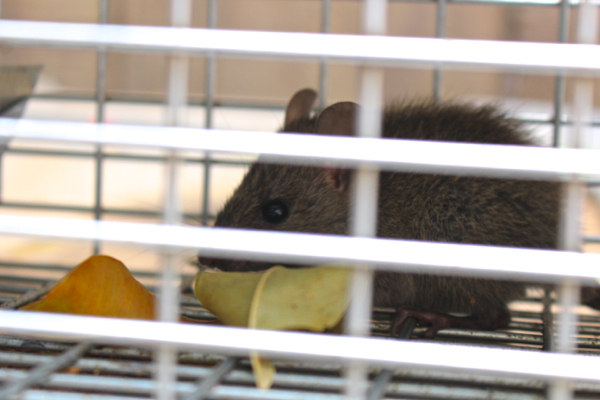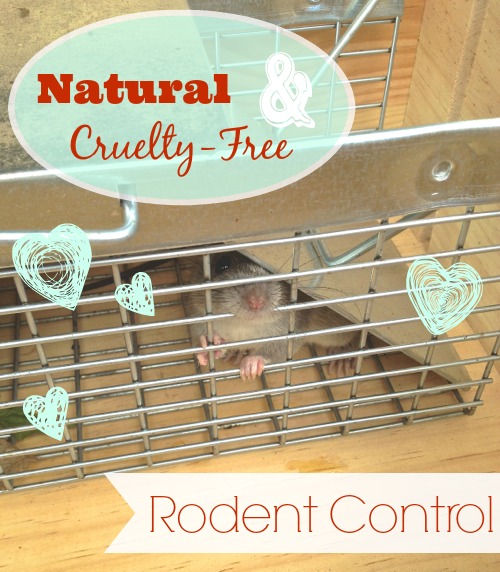I had a rodent problem. Eek! But in my defense, it’s sort of inescapable here. I live near downtown, and right next to a creek. It’s that perfect buffer zone between the rural and the urban that’s an ideal breeding ground for city-friendly wild life. We have a raccoon family that lives above Jeremy’s garage (same family that steals cat food off my friend’s porch, around the corner), opossums in the yard (Harley got ahold of one once and it played opossum, faked it’s death, and sent me to bed in tears thinking my sweet pooch had killed it) and the skunks are . . . well, somewhere. We can smell them! Then of course, there’s the rodents.
Rats and mice just love this neighborhood. Easy picking ’round here, between the residential foraging and whatever winds up creekside. The good life!
And I always knew they were out there, but over time – and especially once I had the compost system set up – they really started making their presence known. In the back yard. In the trees. Multiplying. And then . . . under my house.
OH HELL NO.
So what’s a vegan girl to do?
Prevention

1) Create physical barriers.
If the little critters are finding a way into your home – either under your floor or in your walls, you’ll need to seal off all entry points. Fill every crack, hole, and possible point of access into your house: around the exterior, on the roof, at the crawlspace/attic, and in the foundation. You can have this done professionally, or you can invest some time and do it yourself. Fill small holes with steel wool, which the rodents won’t chew through. Larger openings can be mended with hardware cloth and filler. Repair any damage to vents, and fit them with a screen.
2) Don’t temp them.
You don’t want to do anything that might draw their attention. Namely, food or hiding spots. So make sure your garbage cans and compost bins are on lockdown. Put away any pet food or birdseed that might be available. And finally, trim back or remove any foliage that sits alongside or hangs out over the house.
3) Repel them.
There are a few different natural products reputed to repel rodents. For a homemade solution, try sachets of Balsam Fir, a spray made from peppermint oil or wintergreen oil diluted in water, a spray made from equal parts ammonia and vinegar, or a solution made from 1 gallon water + 1/2 cup dish detergent + 1 tablespoon tabasco sauce. You can also plant peppermint and sage around the yard, which will help to ward off the rodents.
However, if homemade seems like too much hassle, you can go with a more surefire, store-bought solution. I had good luck with Fresh Cab, which the company was nice enough to send to me to sample. This is an all-natural product based on botanic rodent repellants, and it worked wonderfully for me for as long as it was potent. In other words, the rodents returned once the smell had worn off, I’d say 6-8 weeks. I was using this product outside and I imagine it would be more effective when used in close, closed quarters (which is how it’s intended to be used).
Removal

1) Ultrasonic/electromagnetic device.
Somewhere between a repellant and a removal system, these unique instruments emit a very high-frequency sound wave which is imperceptible to humans or non-pest animals, like pets. The sound is supposedly unbearable to rodents, and is reported to keep them away as long as the device is operating.
2) Box traps.
There are a number of no-kill rodent traps on the market, and this is the solution that has worked so well for us. SO well! These traps are awesome and easy to use and of course, cruelty-free! We used this product in both the “chipmunk, rat, and weasel” size (for the rats) as well as the “mouse” size (for the baby rats and mice).
All we did was trap them, drive them to a local park or hiking trail, and let them go. Easy peasy!
These days the yard is pleasantly rodent-free once more. Occassionally, because of the close proximity to downtown and the creek, we’ll hear a wee wanderer out in the garden at night. But all we have to do is set the trap, catch the bugger, and chauffeur him away to his new home, and we’re good to go. That happens pretty rarely, these days.
It is completely possible to rid yourself of rodents without having to harm them. I totally believe that now, and I think my experience is just proof of that. And I hope that if you’re ever facing an infestation of your own, you’ll consider the cruelty-free route.
♥ ♥ ♥
Edited to add: There’s a ton of awesome info and experience being shared in the comments below – please read through those for even more great tips and ideas. And as always, please keep sharing!





Pingback: » Sunday Reading 08-31-14 #4 One Raw Bite
Pingback: Life + Kitchen – September | Veggie Next Door
Pingback: Rat Prevention Tips - ApolloXApolloX